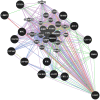Gene expression differences in Longissimus muscle of Nelore steers genetically divergent for residual feed intake
- PMID: 28004777
- PMCID: PMC5177880
- DOI: 10.1038/srep39493
Gene expression differences in Longissimus muscle of Nelore steers genetically divergent for residual feed intake
Erratum in
-
Corrigendum: Gene expression differences in Longissimus muscle of Nelore steers genetically divergent for residual feed intake.Sci Rep. 2017 Apr 5;7:44345. doi: 10.1038/srep44345. Sci Rep. 2017. PMID: 28378785 Free PMC article. No abstract available.
Abstract
Residual feed intake (RFI), a measure of feed efficiency (FE), is defined as the difference between the observed and the predictable feed intake considering size and growth of the animal. It is extremely important to beef production systems due to its impact on the allocation of land areas to alternative agricultural production, animal methane emissions, food demand and cost of production. Global differential gene expression analysis between high and low RFI groups (HRFI and LRFI: less and more efficient, respectively) revealed 73 differentially expressed (DE) annotated genes in Longissimus thoracis (LT) muscle of Nelore steers. These genes are involved in the overrepresented pathways Metabolism of Xenobiotics by Cytochrome P450 and Butanoate and Tryptophan Metabolism. Among the DE transcripts were several proteins related to mitochondrial function and the metabolism of lipids. Our findings indicate that observed gene expression differences are primarily related to metabolic processes underlying oxidative stress. Genes involved in the metabolism of xenobiotics and antioxidant mechanisms were primarily down-regulated, while genes responsible for lipid oxidation and ketogenesis were up-regulated in HRFI group. By using LT muscle, this study reinforces our previous findings using liver tissue and reveals new genes and likely tissue-specific regulators playing key-roles in these processes.
Figures



References
-
- Archer J. A., Richardson E. C., Herd R. M. & Arthur P. F. Potential for selection to improve efficiency of feed use in beef cattle: A review. Austr J Agric Res 50, 147–161 (1999).
-
- Arthur P. F. et al.. Genetic and phenotypic variance and covariance components for feed intake, feed efficiency, and other postweaning traits in Angus cattle. J Anim Sci 79, 2805–2811 (2001). - PubMed
-
- Schenkel F. S., Miller S. P. & Wilton J. W. Genetic parameters and breed differences for feed efficiency, growth, and body composition traits of young beef bulls. Can J Anim Sci 84, 177–185 (2004).
-
- Spurlock D. M., Dekker J. C. M., Fernando R., Koltes D. A. & Wolc A. Genetic parameters for energy balance, feed efficiency, and related traits in Holstein cattle. J Dairy Sci. 95, 5393–5402 (2012). - PubMed
-
- Nkrumah J. D. et al.. Genetic and phenotypic relationships of feed intake and measures of efficiency with growth and carcass merit of beef cattle. J Anim Sci. 85, 2711–2720 (2007). - PubMed
Publication types
MeSH terms
Substances
LinkOut - more resources
Full Text Sources
Other Literature Sources

